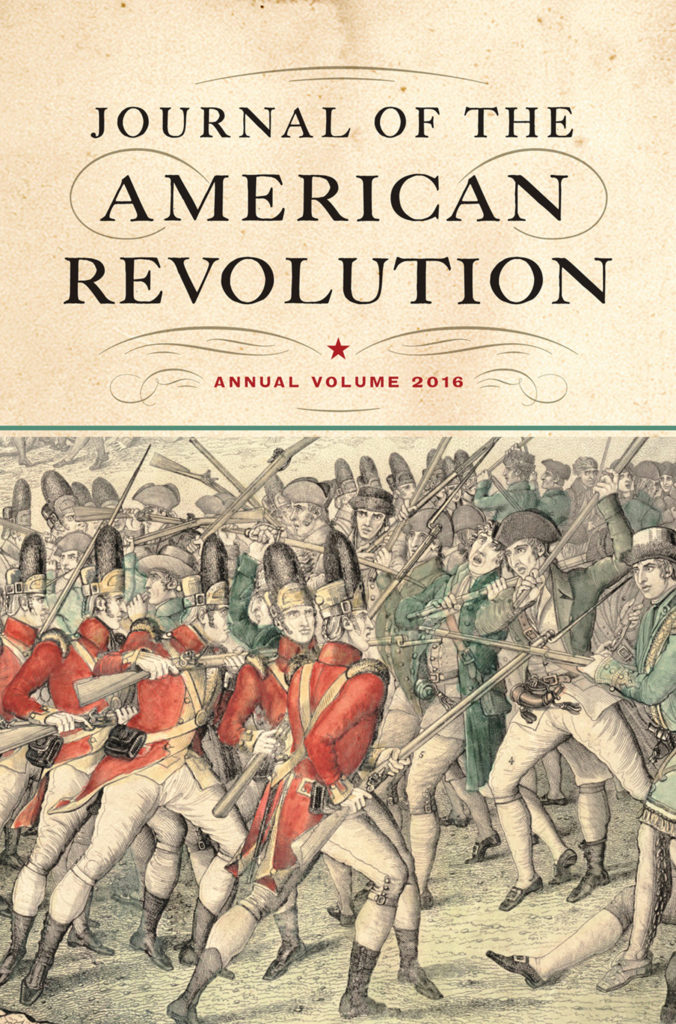

Journal of the American Revolution 2016
Annual Volume
Select Your Format:
Hardback$40.00eBook
$40.00 Add to Cart Save 25% on every book by joining our Book Club


Select Your Format:
HardbackThe Journal of the American Revolution, Annual Volume 2016, presents the journal’s best historical research and writing over the past calendar year. The volume is designed for institutions, scholars, and enthusiasts to provide a convenient overview of the latest research and scholarship in American Revolution studies. The forty-five articles in the 2016 edition are:
The Seed from which the Sons of Liberty Grew by Bob Ruppert
Newton Prince and the Struggle for Liberty by J. L. Bell
Why Did George Washington Become a Revolutionary? by Ray Raphael
Tides and Tonnage: A Different Take on the Boston Tea Party by Hugh T. Harrington
Thomas Gage Reconsidered: When Law Interferes with War by Gary Shattuck
Visiting Boston’s Liberty Tree Site by John L. Smith, Jr.
Prelude to Rebellion: Dunmore’s Raid on the Williamsburg Magazine by Norman Fuss
Patrick Henry’s “Liberty or Death”: Granddaddy of Revolution Mythologies by Ray Raphael
A Fast Ship from Salem: Carrying the News of War by Bob Ruppert
How Paul Revere’s Ride was Published and Censored in 1775 by Todd Andrlik
Richard Williams Maps the Siege of Boston by Allison K. Lange
The Bermuda Powder Raids of 1775 by Hugh T. Harrington
Benjamin Franklin’s Failed Diplomatic Mission by Gene Procknow
Governor Franklin Makes His Move by Thomas Fleming
Russia and the American War for Independence by Norman Desmarais
George Galphin and the War in the South, 1775–1780 by Bryan Rindfleisch
“The Sale of the Hessians” and the Franklin Legend by Hugh T. Harrington
Enlisting Lasses: Women Who Aspired to be Soldiers by Don N. Hagist
Invading America: The Flatboats that Landed Thousands of British Troops on American Beaches by Hugh T. Harrington
British Fascination with Ethan Allen by Gene Procknow
The American Crisis Before Crossing the Delaware? by Jett Conner
Incidents Near Fort Ticonderoga on June 17, 1777 by Michael Barbieri
Forgotten Volunteers: The 1st Company, Governor’s Foot Guard During the Saratoga Campaign by Matthew Reardon
Sir Henry Clinton Attempts to Save the Convention Army by Michael J. F. Sheehan
Captain Gustavus Conyngham: Successful American Naval Captain or Accidental Pirate? by Louis Arthur Norton
Great Intelligence Successes and Failures by Michael Schellhammer
George Washington’s Agent Z: The Curious Case of Lieutenant Lewis J. Costigin by Ken Daigler
Ann Bates: British Spy Extraordinaire by Christian M. McBurney
Hannah Caldwell’s Death: Accident or Murder? by John L. Smith, Jr.
Lafayette’s Second Voyage to America: Lafayette and L’Hermione by Kim Burdick
Fortifying Philadelphia: A Chain of Redoubts and Floating Bridges by Bob Ruppert
The Loyalist Refugee Experience in Canada by Alexander Cain
How was the Revolutionary War Paid For? by John L. Smith, Jr.
Faking It: British Counterfeiting During the American Revolution by Stuart Hatfield
Ten Disabled British Pensioners by Don N. Hagist
Indian Patriots from Eastern Massachusetts: Six Perspectives by Daniel J. Tortora
A Melancholy Accident: The Disastrous Explosion at Charleston by Joshua Shepherd
Murder Along the Creek: Taking a Closer Look at the Sugarloaf Massacre by Thomas Verenna
Light Infantry Never Surrender by Todd W. Braisted
A Yorktown Footnote: The Last Days of Colonel Alexander Scammell by William W. Reynolds
Propaganda Warfare: Benjamin Franklin Fakes a Newspaper by Hugh T. Harrington
India: The Last Battle of the American Revolutionary War by John L. Smith, Jr.
A Spy Wins a Purple Heart by Todd W. Braisted
The Impact of Capt. Jonathan Carver’s Journal and Maps on the 1782–1783 British-American Peace by Merv O. Ahrens
Drilling Holes in George Washington’s Wooden Teeth Myth by John L. Smith, Jr.
Don N. Hagist is managing editor of the Journal of the American Revolution. An expert on the British army in the American Revolution, he is the author of many books and articles, including British Soldiers, American War: Voices of the American Revolution and The Revolution’s Last Men: The Stories Behind the Photographs.
“The Journal of the American Revolution is an exciting experiment that benefits from the combined efforts of independent scholars and professional historians dedicated to re-examining the history of this country’s founding.” —Gregory J. W. Urwin, prize-winning historian, Temple University